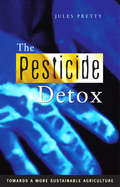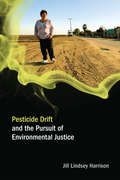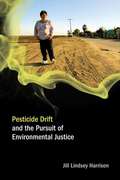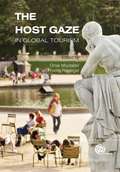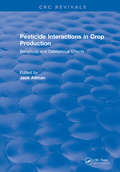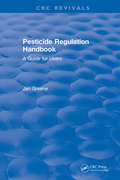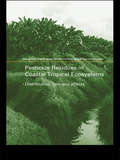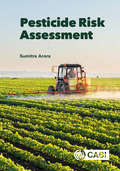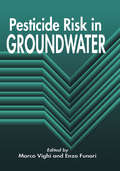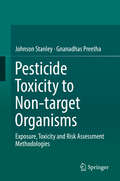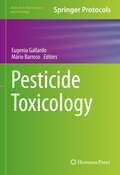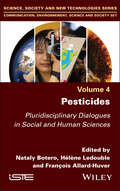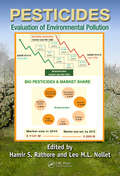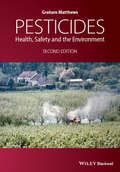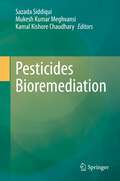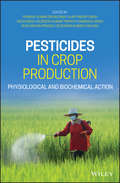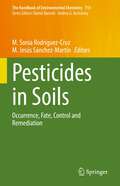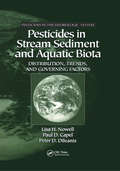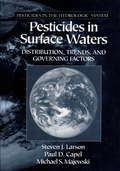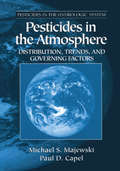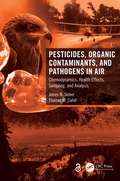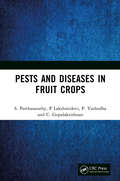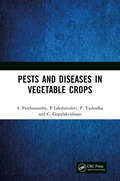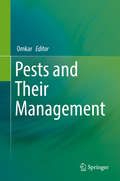- Table View
- List View
The Pesticide Detox: Towards a More Sustainable Agriculture
by Jules PrettySince the 1960s, the world's population has more than doubled and agricultural production per person has increased by a third. Yet this growth in production has masked enormous hidden costs arising from widespread pesticide use - massive ecological damage and high incidences of farmer poisoning and chronic health effects. Whereas once the risks involved with pesticide use were judged to be outweighed by the potential benefits, increasingly the external costs of pesticides, to environments and human health, are being seen as unacceptable. In response to this trend, recent years have seen millions of farmers in communities around the world reduce their use of harmful pesticides and develop cheaper and safer alternatives. The Pesticide Detox explores the potential for the phasing-out of hazardous pesticides and the phasing-in of cost effective alternatives already available on the market. This book makes clear that it is time to start the pesticide detox and to move towards a more sustainable agriculture.
Pesticide Drift and the Pursuit of Environmental Justice (Food, Health, and the Environment)
by Jill Lindsey HarrisonAn examination of political conflicts over pesticide drift and the differing conceptions of justice held by industry, regulators, and activists.The widespread but virtually invisible problem of pesticide drift—the airborne movement of agricultural pesticides into residential areas—has fueled grassroots activism from Maine to Hawaii. Pesticide drift accidents have terrified and sickened many living in the country's most marginalized and vulnerable communities. In this book, Jill Lindsey Harrison considers political conflicts over pesticide drift in California, using them to illuminate the broader problem and its potential solutions. The fact that pesticide pollution and illnesses associated with it disproportionately affect the poor and the powerless raises questions of environmental justice (and political injustice). Despite California's impressive record of environmental protection, massive pesticide regulatory apparatus, and booming organic farming industry, pesticide-related accidents and illnesses continue unabated. To unpack this conundrum, Harrison examines the conceptions of justice that increasingly shape environmental politics and finds that California's agricultural industry, regulators, and pesticide drift activists hold different, and conflicting, notions of what justice looks like. Drawing on her own extensive ethnographic research as well as in-depth interviews with regulators, activists, scientists, and public health practitioners, Harrison examines the ways industry, regulatory agencies, and different kinds of activists address pesticide drift, connecting their efforts to communitarian and libertarian conceptions of justice. The approach taken by pesticide drift activists, she finds, not only critiques theories of justice undergirding mainstream sustainable-agriculture activism, but also offers an entirely new notion of what justice means. To solve seemingly intractable environmental problems such as pesticide drift, Harrison argues, we need a different kind of environmental justice. She proposes the precautionary principle as a framework for effectively and justly addressing environmental inequities in the everyday work of environmental regulatory institutions.
Pesticide Drift and the Pursuit of Environmental Justice
by Jill Lindsey HarrisonThe widespread but virtually invisible problem of pesticide drift--the airborne movement of agricultural pesticides into residential areas--has fueled grassroots activism from Maine to Hawaii. Pesticide drift accidents have terrified and sickened many living in the country's most marginalized and vulnerable communities. In this book, Jill Lindsey Harrison considers political conflicts over pesticide drift in California, using them to illuminate the broader problem and its potential solutions. The fact that pesticide pollution and illnesses associated with it disproportionately affect the poor and the powerless raises questions of environmental justice (and political injustice). Despite California's impressive record of environmental protection, massive pesticide regulatory apparatus, and booming organic farming industry, pesticide-related accidents and illnesses continue unabated. To unpack this conundrum, Harrison examines the conceptions of justice that increasingly shape environmental politics and finds that California's agricultural industry, regulators, and pesticide drift activists hold different, and conflicting, notions of what justice looks like. Drawing on her own extensive ethnographic research as well as in-depth interviews with regulators, activists, scientists, and public health practitioners, Harrison examines the ways industry, regulatory agencies, and different kinds of activists address pesticide drift, connecting their efforts to communitarian and libertarian conceptions of justice. The approach taken by pesticide drift activists, she finds, not only critiques theories of justice undergirding mainstream sustainable-agriculture activism, but also offers an entirely new notion of what justice means. To solve seemingly intractable environmental problems such as pesticide drift, Harrison argues, we need a different kind of environmental justice. She proposes the precautionary principle as a framework for effectively and justly addressing environmental inequities in the everyday work of environmental regulatory institutions.
Pesticide Encyclopedia
by Vasant Gowariker V N Krishnamurthy Kalyani Paranjape Sudha GowarikerIn today's world, food security is an important issue. Food shortages push prices up, impacting upon the health and well-being of hundreds of millions of rural poor across the globe. One way to increase food security is to decrease the amount of yield lost to pests. The Pesticide Encyclopedia provides a comprehensive overview of the fight against pests, covering chemical pesticides, biocontrol agents and biopesticides. It also covers interrelated topics such as pesticide toxicity, legislation and regulation, handling, storage and safety aspects, IPM techniques, resistance management, interaction of pesticides with soil and the environment. An important reference for policy makers, advisers and students and researchers of crop science, this book also includes useful notes on commonly known plant diseases and pests.
Pesticide Interactions in Crop Production: Beneficial and Deleterious Effects
by J. AltmanPesticide Interactions in Crop Production: Beneficial and Deleterious Effects evaluates the effects of pesticides on plants by exploring the physical, chemical, biological, and ecological interactions of pesticides that influence a crop. The effects of pesticides on the environment and on the crop pests themselves are considered as well. Specific topics addressed include iatrogenic responses, the fate of pesticides applied to cereals under field conditions, the persistance of pesticides on target crops, the effect of pesticides on soil symbionts, and the role of ecological agriculture on conventional and organic cropping systems. Pesticide Interactions in Crop Production: Beneficial and Deleterious Effects will be an important volume for agriculturalists, phytologists, mycologists, soil biologists, plant pathologists, tropical ecologists, arboriculturalists, and other researchers interested in the effects of pesticides on crops and soil.
Pesticide Regulation Handbook: A Guide for Users
by Jan GreenePesticide handlers have never had an easy time keeping abreast of the regulations that affect them, but it is getting even more difficult as public pressure adds more layers of new rules. At the same time, there's a trend toward making the individual applicant more responsible for knowing the rules and for getting more training. This is the only volume that, in clear language, describes the system, the current issues in regulation, and the science behind them for the user. It can be helpful for the beginner, the veteran, or anyone who needs a reference encompassing the entire range of pesticide regulatory issues, such as groundwater, endangered species, recordkeeping, worker protection, and more. There's also an exclusive, first-ever compilation of the rules in all 50 states and the District of Columbia for the training and testing required to become a certified applicator-something that varies considerably from state to state.
Pesticide Residues in Coastal Tropical Ecosystems: Distribution, Fate and Effects
by Milton D. Taylor Stephen J. Klaine Fernando P. Carvalho Damia Barcelo Jan EveraartsThe coastal tropics comprise some of the most sensitive and yet the most understudied ecosystems in the world. Coastal plains and river valleys are also home to agriculture on a vast scale, and it is not surprising to find that streams and rivers receive the majority of agricultural runoff, carrying the residues of insecticides, fungicides and othe
Pesticide Risk Assessment
by Dr Sumitra AroraWe have been witnessing a silent chemical revolution over the past half century. Pesticides bring widespread environmental contamination, with residues detected far from their site of application. These substances are playing havoc with the lives of humans and the environment because of their indiscriminate use. Pesticide Risk Assessment describes the environmental risks associated with the injudicious use of pesticides and their mixtures, their methods of estimation and assessment, and their regulation. It also contains methods to reduce and minimize the risks associated with the use of pesticides. The book: Examines pesticides, their impact on the environment, mode of action, estimation methods, risk assessment, mixture toxicity, alternatives for risk reduction, and regulatory aspects. Includes global case studies detailing cases of pesticide poisoning, and the health effects of exposure to pesticides. Covers risks to human health, aquifers and aquatic organisms, pollinators, soil micro flora and fauna, terrestrial organisms and wildlife. Suitable for anyone involved in pesticide application and integrated pest management, this is essential reading for researchers, scientists, extension workers and policy makers.
Pesticide Risk Assessment
by Dr Sumitra AroraWe have been witnessing a silent chemical revolution over the past half century. Pesticides bring widespread environmental contamination, with residues detected far from their site of application. These substances are playing havoc with the lives of humans and the environment because of their indiscriminate use. Pesticide Risk Assessment describes the environmental risks associated with the injudicious use of pesticides and their mixtures, their methods of estimation and assessment, and their regulation. It also contains methods to reduce and minimize the risks associated with the use of pesticides. The book: Examines pesticides, their impact on the environment, mode of action, estimation methods, risk assessment, mixture toxicity, alternatives for risk reduction, and regulatory aspects. Includes global case studies detailing cases of pesticide poisoning, and the health effects of exposure to pesticides. Covers risks to human health, aquifers and aquatic organisms, pollinators, soil micro flora and fauna, terrestrial organisms and wildlife. Suitable for anyone involved in pesticide application and integrated pest management, this is essential reading for researchers, scientists, extension workers and policy makers.
Pesticide Risk in Groundwater
by Marco Vighi Enzo FunariPesticide pollution of groundwater results from agricultural practices, the properties of the substance and its behavior in the soil environment, and the characteristics of aquifers and their vulnerability. Pesticide Risk in Groundwater provides an overview of the main issues concerning pesticide pollution of groundwater worldwide.The book is divided into five sections. Section I reviews experimental data of groundwater monitoring to indicate the extent of the problem on a global basis. Based on this evaluation, herbicides are examined in depth. Section II describes predictive approaches to estimate the distribution and fate of pesticides, and includes a chapter devoted to hydrogeological aspects affecting the vulnerability of aquifers. The third section evaluates pesticides in relation to their toxicology. It critically examines the criteria and procedures by the World Health Organization (WHO) and the U.S. Environmental Protection Agency (EPA) to define quality objectives, and compares the monitoring data on pesticides in groundwater with their quality objectives. Section IV evaluates various strategies to control and prevent groundwater pollution problems. Different water treatment options are described from a technical and economic point of view. The main preventative actions include the chemical approach, the agronomic approach, and the land use approach. The final section reviews the state of the art of drinking water regulations in the EEC, the United States, and other OECD countries. The author describes the economic implications of groundwater pollution and its control and exemplifies with a real case study.
Pesticide Toxicity to Non-target Organisms
by Johnson Stanley Gnanadhas PreethaThe pesticide should cause effect on the target pests and be selective enough to spare the non-target beneficial. The book deals with the pesticide toxicity to predators, parasitoids and microbes which are used for pest management in the agroecosystem. The other beneficials exposed to pesticides are pollinators, earthworms, silkworm and fishes. The book contains information on the modes of pesticide exposure and toxicity to the organisms, sub-lethal effects of insecticides and method of toxicity assessment, risk assessment of pesticidal application in the field. The purpose of the work is to compile and present the different procedures to assess pesticide poising in organisms related to the agroecosystem along with discussions on risk assessment procedures with clear comparison of toxicity of pesticides to target pests and non target beneficial organisms.
Pesticide Toxicology (Methods in Pharmacology and Toxicology)
by Eugenia Gallardo Mário BarrosoThis detailed volume explores practical procedures on the identification and quantification of pesticides in a variety of samples. Chapters guide the reader through methods and protocols for the extraction of pesticides from biological and non-biological samples, pitfalls in dosing techniques and structures identification, and also provide an overview of the problems that these pesticides cause in human populations. As part of the Methods in Pharmacology and Toxicology series, chapters include introductions to their respective topics, lists of reagents and materials, step-by-step guides and reproducible lab protocols, as well as valuable tips on addressing common problems and avoiding known pitfalls. Authoritative and practical, Pesticide Toxicology is an ideal reference for academia, analysts, toxicologists, environmentalists, and health and industry professionals aiming to understand the associated risks and to limit the use of these substances and minimize their potential damage to human health and the environment.
Pesticides: Pluridisciplinary Dialogues in Social and Human Sciences (ISTE Invoiced)
by Nataly Botero Hélène Ledouble François Allard-HuverThe use of pesticides is a subject of intense public debate. Whether in media, legal, terminological or political terms, the subject is migrating from a strictly agricultural universe to a global, social problem. Given the complexity of current and future issues, Pesticides provides a forum for multidisciplinary dialogue and debate on plant protection products within the humanities and social sciences. It presents reflections on the discursive and argumentative activity of the various players and arenas in the debate, and on the development and testing of consensus through controversy and counter-discourse. This book examines the scientific and communication practices of economic and industrial players (influence and lobbying), agricultural practices in terms of pesticide exposure, and the legal proceedings and initiatives of local authorities and associations. It also seeks to shed light on the media coverage of health and environmental issues surrounding pesticides.
Pesticides: Evaluation of Environmental Pollution
by Leo M.L. Nollet Hamir S. RathorePesticides play an important role in controlling pests that carry diseases and threaten crop production. In recent years, however, there has been increased concern about the adverse impacts of pesticides and their degradation products on public health and the environment. A considerable amount of work is being done to develop nonchemical methods of
Pesticides
by Graham MatthewsCrop protection continues to be an important component of modern farming to maintain food production to feed an expanding human population, but considerable changes have occurred in the regulation of pesticides in Europe in the last decade. The aim has been to reduce their impact on people and the environment. This has resulted in a major reduction in the number of chemicals approved for application on crops. In other parts of the world, a continuing expansion in the growing of genetically modified crops has also changed the pattern of pesticide use. In this second edition, Graham Matthews, updates how pesticides are registered and applied and the techniques used to mitigate their effects in the environment. Information on operator safety, protection of workers in crops treated with pesticides and spray drift affecting those who live in farming areas is also discussed. By bringing together the most recent research on pesticides in a single volume, this book provides a vital up to date resource for agricultural scientists, agronomists, plant scientists, plant pathologists, entomologists, environmental scientists, public health personnel, toxicologists and others working in the agrochemical industry and governments. It should assist development of improvements in harmonising regulation of pesticides in countries with limited resources for registration of pesticides.
Pesticides Bioremediation
by Sazada Siddiqui Mukesh Kumar Meghvansi Kamal Kishore ChaudharyThis volume offers the latest theory, procedures, techniques and applications pertaining to the bioremediation of pesticides, as well as current case studies. The book is composed of chapters written by global experts and is divided into three topical sections. Section A deals with concepts and mechanisms of pesticides bioremediation; Section B examines latest tools and techniques; Section C offers global case studies of pesticides bioremediation. The novel methods described here are timely, as traditional pesticide usage leads to high wastage via decay, vaporization and seepage. This of course leads to environmental contamination and has necessitated the development and use of novel technologies like bioremediation for minimizing the impact of pesticides on the environment. This volume will be of relevance to academics, researchers and students who are working in the realm of pesticide bioremediation, and will enable policy makers and managerial experts across the globe in drafting policies and strategies for the management and treatment of pesticides.
Pesticides in Crop Production: Physiological and Biochemical Action
by Prabhat Kumar SrivastavaA guide to the diversity of pesticides used in modern agricultural practices, and the relevant social and environmental issues Pesticides in Crop Production offers an important resource that explores pesticide action in plants; pesticide metabolism in soil microbes, plants and animals; bioaccumulation of pesticides and sensitiveness of microbiome towards pesticides. The authors explore pesticide risk assessment, the development of pesticide resistance in pests, microbial remediation of pesticide intoxicated legumes and pesticide toxicity amelioration in plants by plant hormones. The authors include information on eco-friendly pest management. They review the impact of pesticides on soil microorganism, crops and other plants along with the impact on other organisms like aquatic fauna and terrestrial animals including human beings. The book also contains an analysis of pesticide by GC-MS/MS (Gas Chromatography tandem Mass Spectrometry) a reliable method for the quantification and confirmation of multiclass pesticide residues. This important book: Offers a comprehensive guide to the use of the diversity of pesticides and the pertinent social and environmental issues Explores the impact of pesticides from morphological, anatomical, physiological and biochemical perspectives Shows how pesticides affects soil microorganisms, crops and other plants along with the impact on other organisms like aquatic fauna and animals Critically examines whether chemical pesticides are boon or bane and whether they can be replaced by environmental friendly pesticides Written for students, researchers and professionals in agriculture, botany, entomology and biotechnology, Pesticides in Crop Production examines the effects of chemical pesticides and the feasibility of using bio-pesticides.
Pesticides in Soils: Occurrence, Fate, Control and Remediation (The Handbook of Environmental Chemistry #113)
by M. Sonia Rodríguez-Cruz M. Jesús Sánchez-MartínThis book reviews the occurrence and fate of pesticides in soils, their impact on soil quality and soil ecosystems, and it also provides a comprehensive overview of the latest prevention and remediation strategies of soil contamination. Chapters from expert contributors cover topics such as soil pollution monitoring, the role of dissolved organic matter on the environmental fate of pesticides in soils, the effects of pesticides on soil microbial communities, plant uptake of pesticides from soils, and nano-based pesticides. Particular attention is given to the latest physicochemical and biological technologies developed to immobilize or degrade pesticides, preventing soil and water pollution. Given its scope, the book will appeal to researchers, professionals, including environmental chemists, engineers, ecologists, and policy-makers responsible for soil management.
Pesticides in Stream Sediment and Aquatic Biota: Distribution, Trends, and Governing Factors
by Lisa H. NowellMore than 20 years after the ban of DDT and other organochlorine pesticides, pesticides continue to be detected in air, rain, soil, surface water, bed sediment, and aquatic and terrestrial biota throughout the world. Recent research suggests that low levels of some of these pesticides may have the potential to affect the development, reproduction,
Pesticides in Surface Waters: Distribution, Trends, and Governing Factors
by Steven J. LarsonPesticde use in agriculture and non-agriculture settings has increased dramatically over the last several decades. Concern about adverse effects on the environment and human health has spurred an enormous amount of research into their environmental behavior and fate. Pesticides in Surface Waters presents a comprehensive summary of this research.<BR
Pesticides in the Atmosphere: Distribution, Trends, and Governing Factors
by Michael S. MajewskiMost people know about the presence and health effects of pesticide residues in the water they drink. However, they may not realize the impact of atmospheric transportation and deposition of pesticides on water quality. Scientific studies of pesticides in various atmospheric matrices (air, rain, snow, aerosols, and fog) provide some of the answers.
Pesticides, Organic Contaminants, and Pathogens in Air: Chemodynamics, Health Effects, Sampling, and Analysis
by James N. Seiber Thomas M. CahillThe air is an important but largely unrecognized source of contaminant fate in the environment, including transport of pesticides and contaminants to nontarget areas and exposures for people and wildlife. This book summarizes and places in perspective the potential transport, transformation, and health implications of pesticides and contaminants in air, including the air we breathe. It delves into the hypothesis that the atmosphere is the most significant environmental compartment affecting the overall transport and fate of many classes of environmental contaminants. The authors draw parallels between sampling, analysis, and impact of airborne toxics and particulate matter with the COVID-19 pandemic. Airborne viruses and fine particulate matter, which are of similar size, have remarkable parallels in how they are transmitted and accumulated in the respiratory tract. FEATURES Assesses exposures of people and wildlife to airborne chemicals Includes case study applications, with relevant data summarized for pesticides and contaminants in air Discusses approaches to modeling pesticides’ and contaminants’ dispersion and fate in air Includes an assessment of the physicochemical properties of pesticides and contaminants that influence sampling and atmospheric mobility and fate The authors are global experts in air contaminant research, and this book is well organized and helpful for people interested in regulatory, health, and other topics related to pesticides and contaminants in air. James N. Seiber is a Professor Emeritus at the University of California, Davis. Thomas A. Cahill is an Associate Professor in the School of Mathematical and Natural Sciences at Arizona State University.
Pests and Diseases in Fruit Crops
by S. Parthasarathy C. Gopalakrishnan P Lakshmidevi P. YashodhaThis book provides information about the major diseases of horticultural crops in India and discusses the significant pest, disease, and nematode issues affecting essential fruit crops in the country. It also addresses the management of pests in vegetable crops through several methods such as regulatory, physical, cultural, chemical, and biological approaches, host resistance, and integrated pest management strategies. Print edition not for sale in South Asia (India, Sri Lanka, Nepal, Bangladesh, Pakistan and Bhutan)
Pests and Diseases in Vegetable Crops
by S. Parthasarathy C. Gopalakrishnan P Lakshmidevi P. YashodhaThis book provides information about the major diseases of horticultural crops in India. It discusses the pest, disease, and nematode issues affecting essential vegetable crops in the country. The management of pests in vegetable crops has been addressed through many methods, including regulatory, physical, cultural, chemical, and biological approaches, host resistance, and integrated pest management strategies. The subject matter of the book is helpful for farmers who cultivate vegetable crops and is a valuable reference point for policymakers, researchers, extension workers, and students. Print edition not for sale in South Asia (India, Sri Lanka, Nepal, Bangladesh, Pakistan and Bhutan)
Pests and Their Management
by OmkarThis book comprehensively compiles information on some of the major pests that afflict agricultural, horticultural and medicinal crops in particular as well as many polyphagous pests. Not only does this book deal with the pests of common globally produced crops it also addresses those of rarely dealt with crops such as seed spices, medicinal and aromatic plants. While the perspective of insect pests is largely Indian and South East Asian in context, the book does deal with globally problematic pests, particularly polyphagous ones. Not only will the readers be acquainted with the pests, their damaging potential and their life cycle but also with the latest methods of managements including ecofriendly measures being employed to keep pest populations at manageable levels. The 27 chapters in the book, are grouped into four sections primarily based on crop types, viz. pest of agricultural, horticultural and medicinal crops, and polyphagous pests, making the book easy to navigate. Each of the chapters is comprehensive and well illustrated and written by academicians who have dedicated their entire lives to the study of a particular crop-pest complex. The final chapter of this book provides an overview on the principles and processes of pest management.
